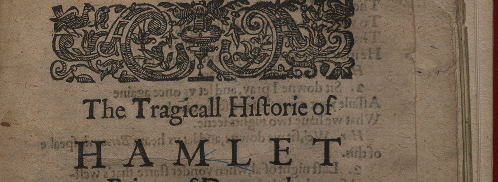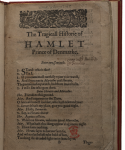The Friday Fillip
One of the glories of the internet and the digital era is their ability to bring the past to us in a lively fashion. And the latest gift from the ages is the Shakespeare Quartos — the early, perhaps the earliest, published volumes of the Bard’s plays. (A quarto is a book size, coming from the fact that the large page on which the text was printed got folded four times before binding. Wikipedia is good on the topic.)

The British Library has teamed up with other institutions holding quartos to make all of them available for your perusal online. Now, this is a feast for scholars, I imagine: they can compare this version of Hamlet with that, make annotations online, and explore printed Elizabethan English in all its quiddities. For the rest of us, it’s a delight and a wonder.
 Take the first page of the first quarto (1603) of Hamlet, for instance. (Click on the thumbnail image to the left to “embiggen” it.) Check out the spelling: “Centinels” “meete” “leegemen” “peece” . . . Notice that “Tis” has no apostrophe. See that Marcellus greets Bernardo with “Holla”, as I might now greet someone in Cuba. All the “u”s for “v”s, and of course long “s”s galore. Italics used for emphasis or to treat some text differently, just as now. And — ouch! — the red British Museum stamp at the bottom, forever marring the historic page. And these are just surface matters on the very first page.
Take the first page of the first quarto (1603) of Hamlet, for instance. (Click on the thumbnail image to the left to “embiggen” it.) Check out the spelling: “Centinels” “meete” “leegemen” “peece” . . . Notice that “Tis” has no apostrophe. See that Marcellus greets Bernardo with “Holla”, as I might now greet someone in Cuba. All the “u”s for “v”s, and of course long “s”s galore. Italics used for emphasis or to treat some text differently, just as now. And — ouch! — the red British Museum stamp at the bottom, forever marring the historic page. And these are just surface matters on the very first page.
The main site lets you explore things in a variety of ways. For example, you can compare the text of various editions: Hamlet 1603 opens with “Stand: who is that? / Tis I.”; Hamlet 1604 opens with “Whose there? / Nay answere me. Stand and vnfolde your selfe.” Each portion that differs is highlighted and keyed so as to highlight the comparable portion in the comparison text. There’s a video about the archive and two about how to use it. And more.
But whatever your ultimate pleasure, I recommend that you leaf through an original quarto, as if you were there, as if it were a book from your own shelves . . .



Yes, that stamp is ‘tragicall’. My initial though was that it might be just part of the image, not on the physical page. However, the stamp doesn’t appear on the next two pages (I didn’t go deeper) so that suggests it’s physical.